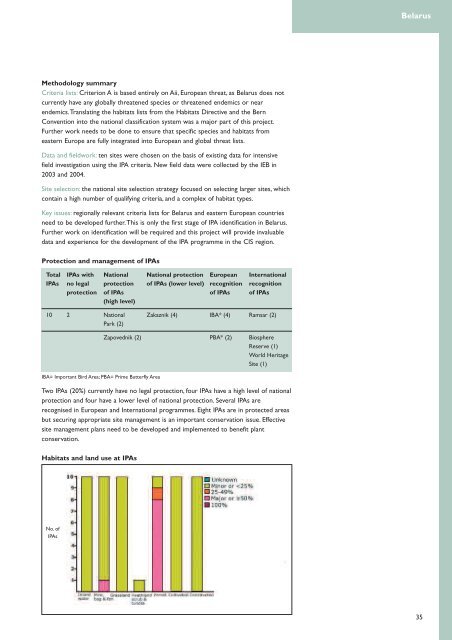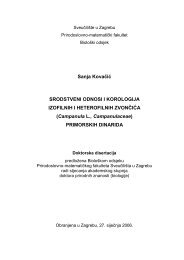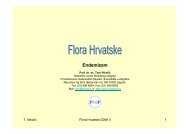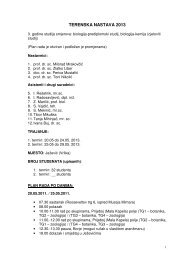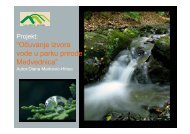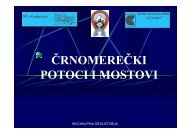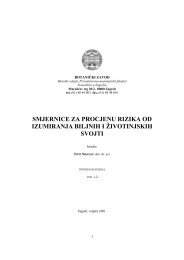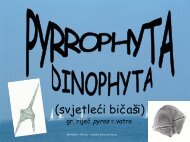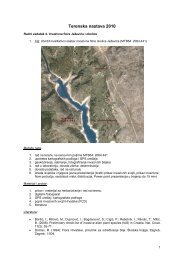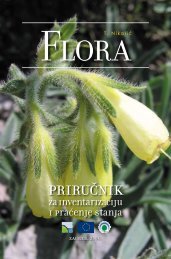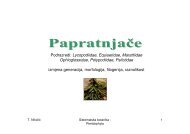important plant areas in central and eastern europe - hirc.botanic.hr ...
important plant areas in central and eastern europe - hirc.botanic.hr ...
important plant areas in central and eastern europe - hirc.botanic.hr ...
You also want an ePaper? Increase the reach of your titles
YUMPU automatically turns print PDFs into web optimized ePapers that Google loves.
BelarusMethodology summaryCriteria lists: Criterion A is based entirely on Aii, European t<strong>hr</strong>eat, as Belarus does notcurrently have any globally t<strong>hr</strong>eatened species or t<strong>hr</strong>eatened endemics or nearendemics.Translat<strong>in</strong>g the habitats lists from the Habitats Directive <strong>and</strong> the BernConvention <strong>in</strong>to the national classification system was a major part of this project.Further work needs to be done to ensure that specific species <strong>and</strong> habitats from<strong>eastern</strong> Europe are fully <strong>in</strong>tegrated <strong>in</strong>to European <strong>and</strong> global t<strong>hr</strong>eat lists.Data <strong>and</strong> fieldwork: ten sites were chosen on the basis of exist<strong>in</strong>g data for <strong>in</strong>tensivefield <strong>in</strong>vestigation us<strong>in</strong>g the IPA criteria. New field data were collected by the IEB <strong>in</strong>2003 <strong>and</strong> 2004.Site selection: the national site selection strategy focused on select<strong>in</strong>g larger sites, whichconta<strong>in</strong> a high number of qualify<strong>in</strong>g criteria, <strong>and</strong> a complex of habitat types.Key issues: regionally relevant criteria lists for Belarus <strong>and</strong> <strong>eastern</strong> European countriesneed to be developed further.This is only the first stage of IPA identification <strong>in</strong> Belarus.Further work on identification will be required <strong>and</strong> this project will provide <strong>in</strong>valuabledata <strong>and</strong> experience for the development of the IPA programme <strong>in</strong> the CIS region.Protection <strong>and</strong> management of IPAsTotal IPAs with National National protection European InternationalIPAs no legal protection of IPAs (lower level) recognition recognitionprotection of IPAs of IPAs of IPAs(high level)10 2 National Zakaznik (4) IBA* (4) Ramsar (2)Park (2)IBA= Important Bird Area; PBA= Prime Butterfly AreaZapovednik (2) PBA* (2) BiosphereReserve (1)World HeritageSite (1)Two IPAs (20%) currently have no legal protection, four IPAs have a high level of nationalprotection <strong>and</strong> four have a lower level of national protection. Several IPAs arerecognised <strong>in</strong> European <strong>and</strong> International programmes. Eight IPAs are <strong>in</strong> protected <strong>areas</strong>but secur<strong>in</strong>g appropriate site management is an <strong>important</strong> conservation issue. Effectivesite management plans need to be developed <strong>and</strong> implemented to benefit <strong>plant</strong>conservation.Habitats <strong>and</strong> l<strong>and</strong> use at IPAsNo. ofIPAs35


